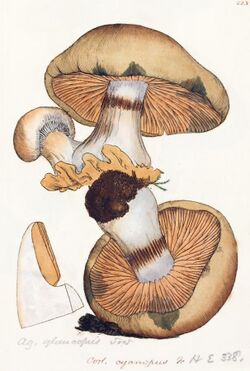Biology:Cortinarius glaucopus
| Cortinarius glaucopus | |
|---|---|

| |
| Scientific classification | |
| Domain: | Eukaryota |
| Kingdom: | Fungi |
| Division: | Basidiomycota |
| Class: | Agaricomycetes |
| Order: | Agaricales |
| Family: | Cortinariaceae |
| Genus: | Cortinarius |
| Species: | C. glaucopus
|
| Binomial name | |
| Cortinarius glaucopus (Schaeff.) Fr. (1838)
| |
| Synonyms[1] | |
|
Agaricus glaucopus Schaeff. (1774) | |
Cortinarius glaucopus, commonly known as the blue-foot webcap, is a basidiomycete mushroom of the genus Cortinarius native to Europe and North America.
The species was first described as Agaricus glaucopus by Jacob Christian Schäffer in 1774.[2] It was given its current name by Elias Magnus Fries in 1838.[3] Within the genus Cortinarius, it is classified in the subgenus Phlegmacium and section Glaucopodes. A 2014 genetic study confirmed it was synonymous with C. glaucopoides and that Cortinarius subrubrovelatus was a distinct species.[4] Common names in other languages include Schwachknolliger Klumpfuss (German), Cortinaire à pied glauque (French) and Szálaskalapú pókhálósgomba (Hungarian).[5]
Description
The fruit bodies of this fungus have convex caps 4 to 12 cm (1.6 to 4.7 in) across and ochre or tawny in colour with prominent darker brown fibres.[6][7] Like other members of the genus, young mushrooms are covered in a web-like veil (cortina) from the cap margin to the stipe.[8] The bulbous stipe is 4–10 cm tall and 1–3 cm wide,[7] pale lilac-blue initially with lower parts fading to yellow-white. The flesh is yellow-white with a blue hue in the upper stipe. The lilac-blue gills are adnate or free, and become brown as the spores mature. The smell, if present, is slightly mealy. The spore print is red-brown and the spores measure 6.5–8.5 by 4.5–5 µm.[6]
Fruit bodies appear from August onwards into autumn in deciduous and coniferous forests, often in profuse numbers.[8] It can be found in fairy rings.[9]
Cortinarius glaucopus is found in Western North America (both the United States and Canada),[10] and is common in the Rocky Mountains.[9] It is rare east of the Great Plains;[10] it is rare in the British Isles.[6]
Cortinarius glaucopus forms ectomycorrhizae that are unusually hydrophobic (water-repellent) compared with other fungi, which has led to interest in decoding its genome. DNA studies indicate it may decompose toxic polycyclic aromatic compounds in the soil with specially adapted oxidizing enzymes.[11]
Similar species
Similar species include C. caerulescens,[7] C. pansa,[4] C. sodagnitus,[7] and C. subfoetens.[4]
Edibility
The flesh is mild tasting,[6] and not highly regarded. It is considered inedible,[12] and because it closely resembles many other species, including those that are deadly poisonous,[7] it should definitely not be eaten.[13] In Tlaxcala, Mexico, it is collected in June and sold in the market.[14]
See also
References
- ↑ "Cortinarius glaucopus (Schaeff.) Fr.". Index Fungorum. CAB International. http://www.speciesfungorum.org/Names/SynSpecies.asp?RecordID=230205.
- ↑ Schaeffer JC. (1774) (in la). Fungorum qui in Bavaria et Palatinatu Nascuntur Icones. 4. p. 23.
- ↑ Fries EM. (1838) (in la). Epicrisis Systematis Mycologici: Seu Synopsis Hymenomycetum. 1-2. Uppsala, Sweden: Regiae Academiae Typographia. p. 264. http://www.librifungorum.org/Image.asp?Nav=yes&FirstPage=292091&LastPage=292716&NextPage=292368.
- ↑ 4.0 4.1 4.2 "The largest type study of Agaricales species to date: bringing identification and nomenclature of Phlegmacium (Cortinarius) into the DNA era". Persoonia 33: 98–140. 2014. doi:10.3767/003158514X684681. PMID 25737596.

- ↑ Phillips R (2015). "Cortinarius glaucopus". RogersMushrooms. Rogers Plants Ltd.. http://www.rogersmushrooms.com/gallery/DisplayBlock~bid~5395.asp.
- ↑ 6.0 6.1 6.2 6.3 Phillips R. (2006). Mushrooms. London, UK: Pan MacMillan. p. 172. ISBN 978-0-330-44237-4.
- ↑ 7.0 7.1 7.2 7.3 7.4 Davis, R. Michael; Sommer, Robert; Menge, John A. (2012). Field Guide to Mushrooms of Western North America. Berkeley: University of California Press. pp. 257-258. ISBN 978-0-520-95360-4. OCLC 797915861. https://www.worldcat.org/oclc/797915861.
- ↑ 8.0 8.1 Haas H. (1969). The Young Specialist Looks at Fungi. London, UK: Burke. p. 116. ISBN 978-0-222-79409-3.
- ↑ 9.0 9.1 Evenson VS (1997). Mushrooms of Colorado and the Southern Rocky Mountains. Big Earth Publishing. pp. 121. ISBN 9781565791923. https://books.google.com/books?id=EAeDeyqZLq0C&q=Cortinarius+glaucopus&pg=PA121.
- ↑ 10.0 10.1 A Field Guide to Mushrooms: North America. Houghton Mifflin Harcour. 1998. pp. 291. ISBN 9780395910900. https://books.google.com/books?id=kSdA3V7Z9WcC&q=Cortinarius+glaucopus&pg=PA291.
- ↑ "Cortinarius glaucopus". JGI: Mycocosm: The Fungal Genomics Resource. The Regents of the University of California. 2014. http://genome.jgi.doe.gov/Corgl3/Corgl3.home.html.
- ↑ Phillips, Roger (2010). Mushrooms and Other Fungi of North America. Buffalo, NY: Firefly Books. p. 166. ISBN 978-1-55407-651-2.
- ↑ Whitney, Stephen (1985). Western Forests (The Audubon Society Nature Guides). New York: Knopf. p. 495. ISBN 0-394-73127-1. https://archive.org/details/westernforests00whit/page/495.
- ↑ "Useful wild fungi of La Malinche National Park, Mexico". Fungal Diversity. Chiang Mai, Thailand: The Mushroom Research Foundation. pp. 115–43. http://www.fungaldiversity.org/fdp/sfdp/17-8.pdf.
Wikidata ☰ Q3694823 entry

